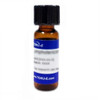Tulathromycin is a semi-synthetic derivative of erythromycin belonging to the ring expanded aza-erythromycins. Ring expansion improves the acid lability compared with the parent erythromycins. Tulathromycin is regarded as the first of the triamilides, structurally similar to azithromycin and having a third amino (propylaminomethylene) group on a sugar to improve absorption. This modification provides a stable mixture of Tulathromycin isomers when in aqueous solution, in a 9:1 ratio. Tulamycin A (CP-472,295 a 15-ring member) is the major component, and Tulathromycin B (CP-547,272, a 13-ring member) the minor component. It is used in animal research applicaitons, and is active against the bacteria causing bovine and swine bacterial respiratory diseases. LC-MS methods have been reported for Tulathromycin in plasma and tissue samples in cattle, swine, goats, and foals.
Tulathromycin A is soluble in ethanol and DMSO but is practically insoluble in water.
| Molecular Formula | C41H79N3O12 |
| Mechanism of Action | Tulathromycin A binds to the 50S subunit of the bacterial ribosome, interfering with bacterial protein synthesis. |
| Spectrum | Tulathromycin A is effective against Gram-negative bacteria with mixed bacteriostatic and bactericidal activity. |
| Eukaryotic Cell Culture Applications | Tulathromycin A was used to assess primary DNA damage using in vitro Comet assay in isolated rat lymphocytes. Lymphocytes were treated with Tulathromycin (1-100 µM) and co-treatment with an antioxidant, catalase (100 IU/ml and 500 IU/ml). The highest concentrations of Tulathromycin (50 and 100 µM) caused significant increase of DNA damage in rat lymphocytes and catalase did not significantly reduce the DNA-damaging effect of Tulathromycin. The results of this study indicate that Tulathromycin induces genotoxic effects at high concentrations and catalase does not exert protective effect in this case (Jelena, 2015). |
| References |
Boison JO (2016) A single laboratory-validated LC-MS method for the analysis of Tulathromycin residues in bison and deer sera and selected tissues of white-tailed deer. Drug Test Analysis 8:584-595 Evans NA (2005) Tulathromycin: An overview of a new triamilide antibiotic for livestock respiratory disease. Vet Ther. Summer 6(2):83-95 PMID 16094557 Gáler D et al (2004) An analytical method for the analysis of Tulathromycin, an equilibrating triamilide, in bovine and porcine plasma and lung. J. Agric. Food Chem. 52:2179 Jelena M (2015) Evaluation of DNA damage in rat lymphocytes exposed to Tulathromycin in vitro. Genetica. 47(1):339-348 Letavic MA et al (2002) Synthesis and activity of a novel class of tribasic macrocyclic antibiotics: The triamilides. Bioorg. Med. Chem. Lett. 12:2771 |



